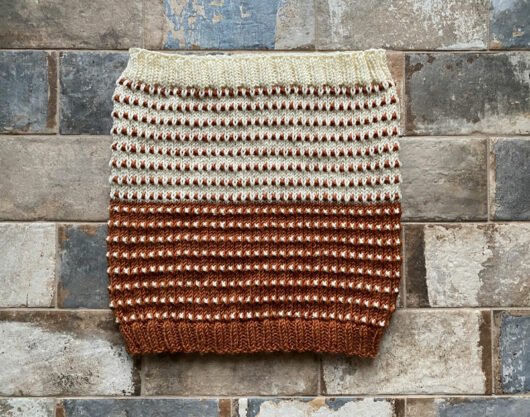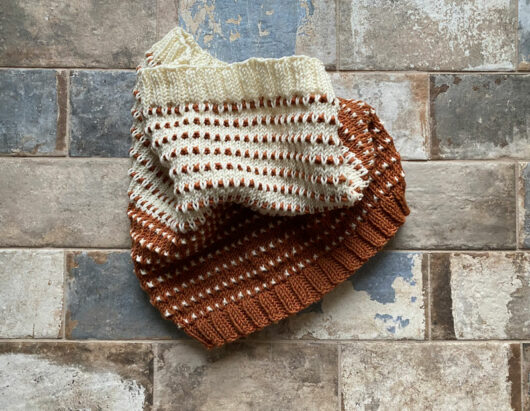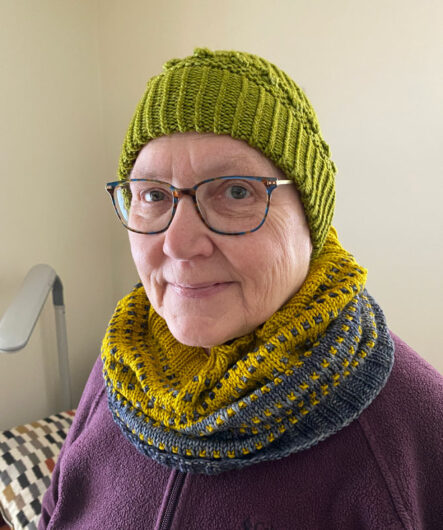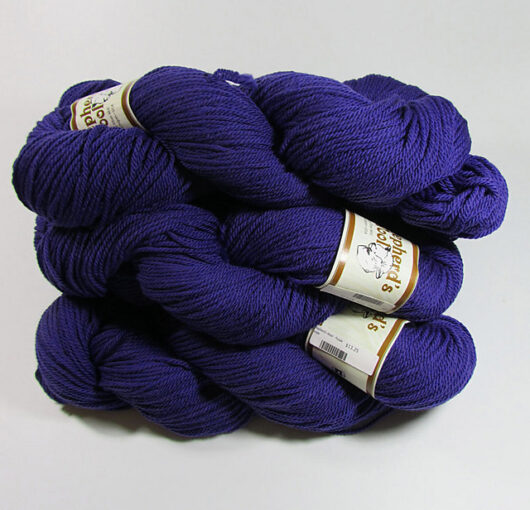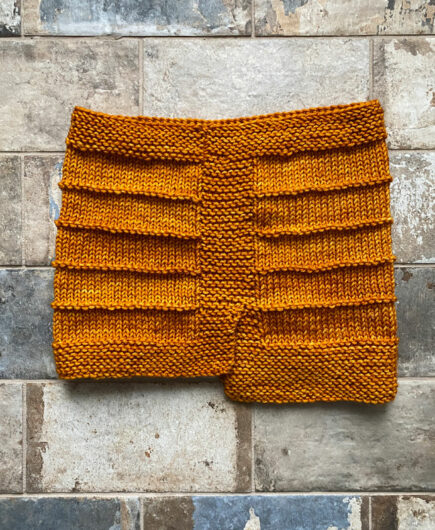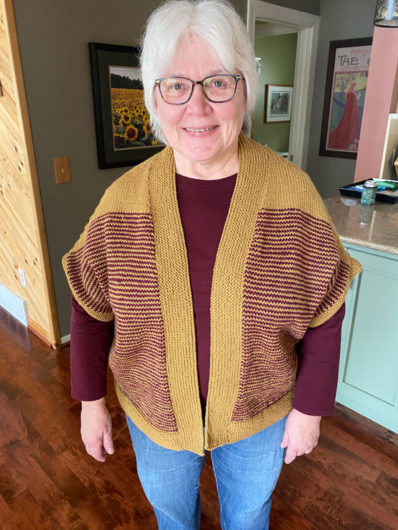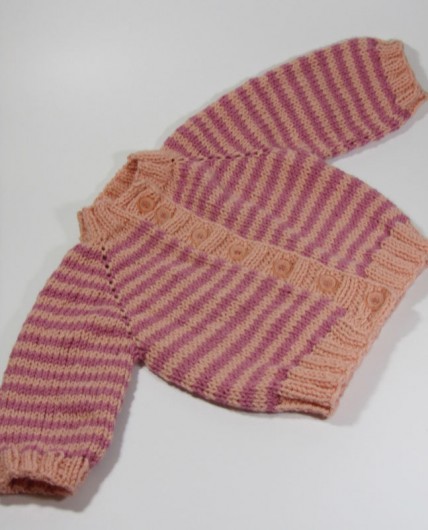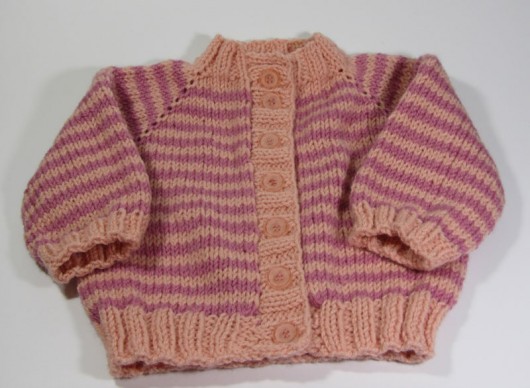I’m in some sort of belated Groundhog Day loop. And I didn’t even like that movie. Because I’m still having a good time knitting stuff more than once. This nifty cowl is Elizabeth Smith’s Soundtrack Cowl. I knit this first one in Malabrigo Rios and used the Frank Ochre (the gold) and Tormenta (the gray) colorways. 160 yards (76 grams) of each color completed the cowl. It’s been one of my go-to accessories this winter. The Rios is next-to-the-neck soft superwash merino. The easy slip stitch pattern worked out perfectly.
To make the cowl a bit wider in circumference, I cast on 136 instead of the 116 stitches the pattern called for. Unblocked the cowl was 12.75 tall by 26.5 inches in circumference. Steam-blocked gently, my cowl is 13″ tall and 28″ in circumference.
Here’s the designer’s Soundtrack Tips page, including how to carry the non-dominant color over the stockinette section without having it show through at the round change. See 6:25-8:50 into the video for that tidbit. Essentially, Smith recommends gently twisting the yarns only after round 4 of the pattern. That worked well.
Next I tried the Soundtrack Cowl in Plymouth Yarns Worsted Merino Superwash, in Cream and Caraway Heather. It used exactly the same amount of yarn as my first Soundtrack. I handled the finished cowl exactly the same, a light steaming. But the yarn didn’t relax into the pattern to the same extent as the Rios did. I like this version, quite a bit actually. But I’m not as satisfied that the yarn was best for the pattern. The single slipped stitches, especially in the creamy top section, seem a tad too dominant. The Plymouth yarn has great stitch definition, maybe a bit too great? It’s a nicely rounded bouncy yarn. It doesn’t want to chill out to the same extent as Rios.
Here’s a look at how nicely Soundtrack sits at the neck. And as a bonus you can choose what colorway you want to have next to your face.
Next comes a blog mainstay: Chris Basta’s great freebie pattern Better Dorm Books for Men. I’d link to all my various versions of these, but we’d all find that tedious. I make a few easy modifications. Instead of knitting with two strands of worsted weight, I use a bulky weight. And I lengthen the cuff so it can be folded over.
This pair is knit in King Cole Chunky Tweed in the Orkney colorway. They’re knit flat, on US size 10 needles, and can be completed before the fourth episode of The Great British Baking Show names the Star Baker. Truly a pattern to be trusted. When binding off at the cuff, I use a size 11 and a very relaxed grip. That’s because cutting off circulation at the ankles isn’t a good plan for feet.
As slippers, the soles aren’t grippy enough unless you apply some of that plastic goop or make another plan for safety on hard surfaces. But as bed socks they are the best! They kick off easily once feet warm. But they stay in place even for restless sleepers.
Here’s the same pattern in Plymouth Yarn Encore Chunky. I especially like this Garnet Mix colorway.
Better Dorm Boots for Men work equally well for women’s feet, of course. But if you’re looking for a more decorative cuff try Basta’s Better Dorm Boots Deluxe. Again, I use a bulky or chunky weight instead of doubling worsted. Why? To me, the resulting socks are more cozy and less stiff feeling. Plus, I’ve never really taken to doubling yarn and yardage if I can manage the pattern with one strand.
This first “deluxe” pair is knit in King Cole Shadow Chunky, in Black Currant.
If you’ve wondered what these dorm boots look like before being stitched up, here’s a look. You’re seeing the reverse side of the cuff. Be sure to shift the right side to the wrong side as you work the cuff so the lacy detail will end up on the public/right side of the slipper.
And here’s Better Dorm Boots Deluxe worked in strong solid shade (Burgundy) of Plymouth Yarn Encore Chunky. When I knit the largest size, on size 10 US needles, the bedsocks easily fit a woman’s foot from size 8-10. And they’d easily stretch to fit larger feet.
This is the first time I’ve knit the XL largest size. I’m pretty sure that there’s an error on the XL directions at row 54. Row 51 confirms there should be 34 stitches after the one-stitch decrease in that row. No other stitch count change comes in for the XL size until Row 54. There are 4 YO’s on Row 54, and the stitch count is said to be 37 after that row. Obviously 34 plus 4 is 38. You need 37 stitches to make the lacework on the cuff work out correctly. So on row 54 for the XL size I made 3 YOs instead of 4. That worked.
It’s getting to be a bit of long, cold, windy winter “up north” in Michigan. This pair of Rachel Borello Carrol’s Little Kindness Monsters brought some February sunshine. I knit my set in Novita 7 Veljesta Solids. Please forgive that I don’t know how to type the two-dot umlaut in the yarn name that belongs above the “a” and my hopeless provincialism.
This freebie is totally cute just as the designer wrote the pattern. But I decided to shorten the hats some, knitting 12 rounds of ribbing instead of what the pattern called for. And I knit one round in between each of the k2 together rounds in the crown decreases. On round 15 of the head, I knit 8 stitches and then “planted” a purl stitch on either side of those 8 to mark where I’d attach the safety eyes. I added a nose because I thought it would help distract some from the still wide-set eyes.
The designer suggests we duplicate stitch a heart on the monster’s left side, below the mouth. They are super cute that way. But I stink at duplicate stitch. My monsters are heartless. But my granddaughter loves them!


